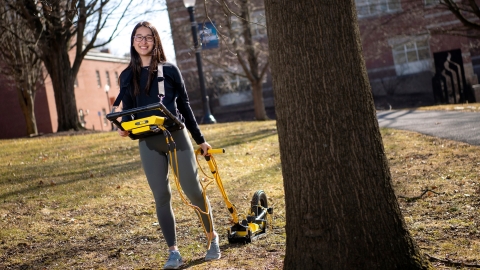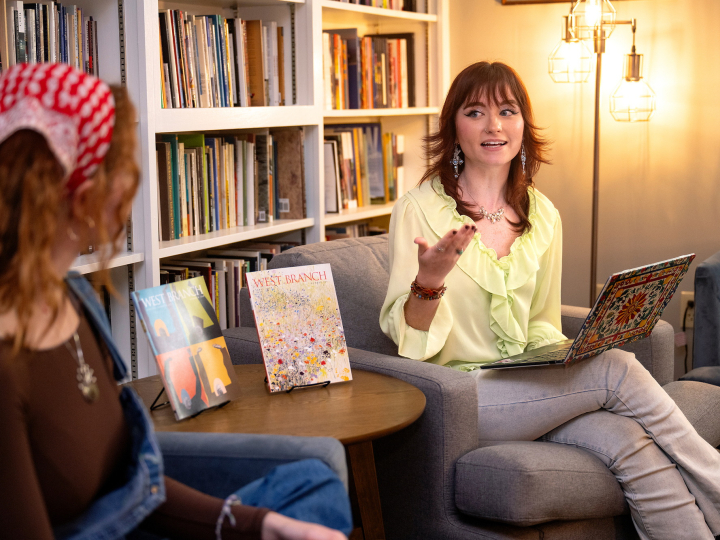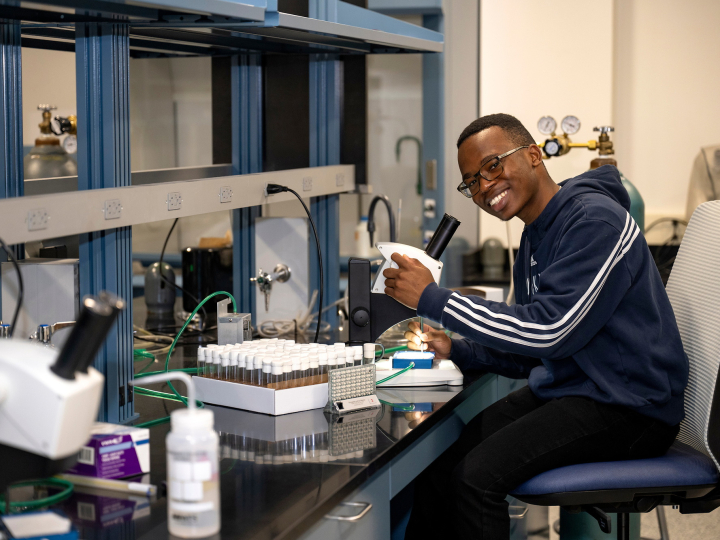
Jordan Isaacs '23, Geology and Biology
August 29, 2022
Jordan Isaacs '23 collects data on tree roots via ground-penetrating radar (GPR), a non-destructive method of surveying the subsurface. Photo by Emily Paine, Communications
The chance to declare two majors that both emphasize learning in the lab and in the field is something that, I think, is unique to a school like Bucknell.
While much is known about the Earth's structure, properties and processes, there's still plenty to discover about the ground under our feet. So how do we get a clearer picture of what's going on underground?
Students like Jordan Isaacs '23 are working to find the answer. As a geology and biology double-major, she's using advanced techniques and technology to see what lies beneath — without digging up any dirt.
Since her junior year, Isaacs has been working with Professor Rob Jacob '97, geology & environmental geosciences, to collect data on tree roots via ground-penetrating radar (GPR). A non-destructive method of surveying the subsurface, GPR produces an image of underground materials by transmitting electromagnetic pulses.
"The machine itself kind of resembles a lawn mower — it's got a handle that you use to simply drag it over the ground," Isaacs explains. "It works by operating two detectors, one that sends out a pulse and another that receives pulses as they reflect off of objects underground. Those signals can then be translated into an 2D image that shows exactly where those objects are."
GPR has been used by geophysicists to identify soil conditions, structure and characteristics that may affect agriculture. In some cases, vegetation root systems can also be detected in the data.
To get a glimpse of the underground networks on campus, Isaacs spent the fall 2021 semester surveying the ground around the University's many trees — some of which are as old as Bucknell itself. She then entered the data from the GPR machine into a computer imaging program, which yielded complex results.
"One of the tricky things about this type of imaging is being able to identify what you're looking at, because what you're seeing on the screen is just disturbances in the waves," Isaacs says. "Is that irregularity a pipe or a root? You have to visualize it three-dimensionally in order to deduce what you've found."
Sometimes, what Isaacs observed in her data wasn't buried at all.
"I quickly realized that the state of the ground could impact how clear the images came out. If there are a lot of pine cones or mulch, then there'll be more noise in the data," she says. "It's really cool to be able to learn a new piece of equipment and work through challenges like that. Getting to experience research both in the field and in the lab has been so beneficial for me."
The Perfect Combination
Isaacs' work is a natural extension of her curiosity about the planet and its processes, which developed while in high school. As a member of the Envirothon program — an academic competition similar to Science Olympiad — the Media, Pa., native studied the health of local creeks, streams and rivers firsthand. Isaacs chose Bucknell so she could continue to explore her passions through real-world experiences.
She began in her sophomore year, partnering with Professor Matthew McTammany, biology and environmental studies & sciences, on an experimental study aimed at restoring Central Pennsylvania tributaries. Conducted as part of her Presidential Fellowship, the project helped Isaacs "take the skills I gained in the lab and directly apply them in the local community," while also expanding her knowledge of environmental biology.
It wasn't until she took a course in Environmental Geohazards that Isaacs saw the opportunity to dive deeper into her love of earth sciences through a double major in geology.
"The course covered natural disasters in relation to geologic processes, such as landslides, for example. It opened my eyes to learning about the environment in a whole new way," Isaacs says. "One of the greatest things about Bucknell is that it's a liberal arts school where you can combine your interests. Being able to pursue so many different opportunities is something that's just not offered at other schools the way it is here."

